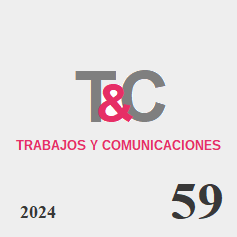La representación de Carlos I de Inglaterra a partir de la pintura (siglos XVII-XIX)
Contenido principal del artículo
Resumen
Carlos I fue quizás uno de los monarcas más controvertidos de la historia británica principalmente, aunque no exclusivamente, por la decisión de ir a una Guerra Civil que dividió a sus reinos. Uno de los elementos que ha sido objeto de estudio por parte de los historiadores es la representación de su persona, esto es, la imagen del Rey. El presente trabajo pretende analizar cómo la pintura reflejó la imagen de Carlos I durante el Seiscientos y cómo ésta fue reapropiada en el siglo XIX, cuando Inglaterra atravesaba su más radical transformación en la cual los retratos del monarca adquirieron una nueva significancia.
Descargas
Detalles del artículo

Esta obra está bajo una licencia internacional Creative Commons Atribución-NoComercial-CompartirIgual 4.0.
La cesión de derechos no exclusivos implica también la autorización por parte de los autores para que el trabajo sea alojado en los repositorios institucionales UNLP (Sedici y Memoria Académica) y difundido a través de las bases de datos que los editores consideren apropiadas para su indización, con miras a incrementar la visibilidad de la revista y sus autores.
Citas
Baker, P. (2018). e regicide. En M. Braddick (Ed.), e Oxford Handbook of the English Revolution (pp. 154-167). Oxford: Oxford University Press.
Barnes, S., Millar, O., Vey, H. y De Poorter, N. (2004). Van Dyck: A complete catalogue of paintings. New Haven: Yale University Press.
Braddick, M. (1996). e Nerves of State. Taxation and the financing of the English state, 1558-1714. Manchester y Nueva York: Manchester University Press.
Braddick, M. (2008). God’s Fury, England’s Fire. A new History of the English Civil Wars. Londres: Allen Lane.
Brown, J. (1999). Introducción: tres pintores cortesanos. En J. Brown (Dir.), Velázquez, Rubens y Van Dyck. Pintores cortesanos del siglo XVII (pp. 33-49). Madrid: Museo Nacional del Prado.
Charles, I. (1649). Eikon Basilike. e pourtraicture of his Sacred Majestie in his solitudes and sufferings.
Coward, B. y Gaunt, P. (2017). e Stuart Age. England, 1603-1714 (5th edition). Londres: Routledge. DOI: https://doi.org/10.4324/9781315271552
Cust, R. (2005). Charles I, a political life. Harlow: Pearson Longman.
Cust, R. (2018). e collapse of royal power in England 1637-1642. En M. Braddick (Ed.), e Oxford Handbook of the English Revolution (pp. 60-75). Oxford: Oxford University Press.
Elliot, J. (1999). La sociedad cortesana en la Europa del siglo XVII: Madrid, Bruselas, Londres. En J. Brown (Dir.), Velázquez, Rubens y Van Dyck. Pintores cortesanos del siglo XVII (pp. 15-31). Madrid: Museo Nacional del Prado.
Falomir Faus, M. (1998). Imágenes de poder y evocaciones de la memoria, usos y funciones del retrato en la corte de Felipe II. En Un príncipe del renacimiento: Felipe II, un monarca y su época [exposición]: Museo Nacional del Prado, 13 de octubre de 1998 - 10 de enero de 1999. Madrid: Sociedad Estatal para la Conmemoración de los Centenarios de Felipe II y Carlos V.
Gardiner, S. R. (1887). The History of England om the Accession of James I to the Outbreak of Civil War 1603-1642 in ten volumes, Vol. 1. Londres: Longmans, Green and Company.
Gardiner, S. R. (1889). The History of England from the Accession of James I to the Outbreak of Civil War 1603-1642 in ten volumes, Vol. 2 (3ra edición). Londres: Longmans, Green and Company.
Gardiner, S. R. (1890.). The History of England from the Accession of James I to the Outbreak of Civil War 1603-1642 in ten volumes, Vol. 3-10. Londres: Longmans, Green and Company.
Gardiner, S. R. (1899). The constitutional documents of the Puritan Revolution, 1625-1660. Oxford: Clarendon Press.
Goodare, J. (2018). The rise of the covenanters, 1637-1644. En M. Braddick (Ed.), e Oxford Handbook of the English Revolution (pp. 43-59). Oxford: Oxford University Press.
Howarth, D. (1997). Images of rule. Art and politics in the English Renaissance, 1485-1649. Londres: Macmillan. DOI: https://doi.org/10.1007/978-1-349-25481-1
Knoppers, L. (2018). Cultural legacies: the English Revolution in 19th c. British and French literature and art”. En M. Braddick (Ed.), The Oxford Handbook of the English Revolution (pp. 535-550). Oxford: Oxford University Press.
Macaulay, T. B. (1906). The History of England om the Accession of James the Second in 6 Volumes. Londres: Longmans, Green and Company.
McIlwan, C. (1965). The political works of James I. Nueva York: Russell y Russell, Inc.
Morrill, J. (2018). The English Revolution in British and Irish context. En M. Braddick (Ed.), e Oxford Handbook of the English Revolution (pp. 555-576). Oxford: Oxford University Press.
Peacock, J. (1994). e Politics of Portraiture. En K. Sharpe y P. Lake (Eds.), Culture and Politics in Early Stuart England (pp. 199-229). Londres: Macmillan. DOI: https://doi.org/10.1007/978-1-349-23193-5_9
Rebecchini, G. (2018). Charles I’s visit to Madrid. En P. Rumberg y D. Shawe Taylor (Eds.), Charles I, King and collector (pp. 49-53). Londres: Royal Academy of Arts.
Redworth, G. (2003). The Prince and the Infanta. e Cultural Politics of the Spanish Match. New Haven y Londres: Yale University Press.
Russell, C. (1979). Parliaments and English politics, 1621-1629. Oxford: Clarendon Press. DOI: https://doi.org/10.1093/acprof:oso/9780198224822.001.0001
Russell, C. (1990). e Causes of the English Civil War. Oxford: Clarendon Press. DOI: https://doi.org/10.1093/oso/9780198221425.001.0001
Sharpe, K. (1987). The image of virtue: the court and household of Charles I, 1625-1642. En D. Starkey (Ed.), The English Court om the War of the Roses to the Civil War”. Essex: Longman.
Sharpe, K. (1992). The Personal Rule of Charles I. New Haven y Londres: Yale University Press.
Sharpe, K. (2010). Image Wars. Promoting Kings and Commonwealths in England, 1603-1660. New Haven y Londres: Yale University Press. DOI: https://doi.org/10.12987/yale/9780300162004.001.0001
Sharpe, K. (2013). Reading Authority and Representing Rule in Early Modern England. Londres: Bloomsbury.
Shaw-Taylor, D. (2018). The “Act and power of a face: van Dyck’s royal portraits. En En P. Rumberg y D. Shawe Taylor (Eds.), Charles I, King and collector (pp. 126-148). Londres: Royal Academy of Arts.
Ollard, R. (1979). The Image of the King, Charles I and Charles II. Nueva York: Atheneum.
Tyacke, N. (1987). Anti-Calvinists. The rise of English Arminianism c. 1590-1640. Oxford: Clarendon Press.
